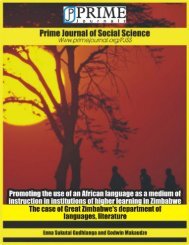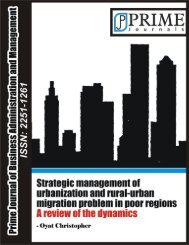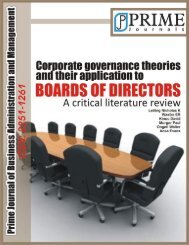See Full Article [pdf] - prime journals limited
See Full Article [pdf] - prime journals limited
See Full Article [pdf] - prime journals limited
Create successful ePaper yourself
Turn your PDF publications into a flip-book with our unique Google optimized e-Paper software.
Prime Research on Education (PRE)ISSN: 2251-1253. Vol. 2(7), pp. 301-308, 29 th August 2012www.<strong>prime</strong>journal.org/PRE© Prime Journals<strong>Full</strong> Length ResearchStudents’ perception of learner support services at theNational Open University of Nigeria (Noun)Clifford Moses AminiRetridal,National Open University of Nigeria,14-16 Ahmadu Bello Way, Victoria Island, Lagos.E-mail: amini.clifford@gmail.comAccepted 24 th July, 2012454 distance learning students of the National Open University of Nigeria, out of a population of over 30,000were used as sample for the study. The students were made to respond to a Likert type structuredquestionnaire students perception of Learners support services questionnaire (SPLSSQ). The SPLSSQ which iscomposed of 97 items covers facilitation, information, orientation, registration, matriculation, counseling,assessment/evaluation, course materials, multimedia, support staff as support services in NOUN. Theresponses which constituted their perception of support services in NOUN were analyzed using percentages.Results show that students’ perception responses were high in respect of counseling, facilitation, information,assessment/evaluation, multimedia, and support staff. Low perceptions were recorded for registration andorientation.Key words: Learner support services, students, National Open University of Nigeria.INTRODUCTIONOpen and distance education system presupposes thatstudents and teachers do not necessarily need to meetface-to-face before knowledge can be transmitted andlearners learned. This means that there must be servicesrendered through media that will make teachers to reachtheir students without necessarily meeting them. Thesesupport services as they called are integral part of andare necessary for the overall working of the Open andDistance Learning (ODL) System.Historically, Distance Learning System (DLS) had beenin practice in the advanced world of the West for somedecades before its introduction in the Nigerian EducationSystem. During the nineteenth century, in the UnitedStates, several activities in adult education preceded theorganization of University extension beyond the campuses.In 1873, Anna Ticknor created the society toencourage studies at home for the purpose of educationalopportunities for women of all classes in the society(Nasseh, 2005. This Boston-based, largely volunteereffort provided correspondence institution to 10,000members over a 24-years period despite it‟s relatively lowprofile. Printed materials sent through the mail were themain method of communication, teaching and learning. In1883, a correspondence University with headquarters atCornel University was established, but never got off theground (Nasseh, 2005).The National Open University of Nigeria, was establishedby Law in 1983, and actually made to function in2003. The Nigerian approach to Open and DistanceLearning, especially with NOUN and NTI is the establishmentof study centres throughout the states of thefederation, with course facilitators who engage studentsin face-to-face tutorials using the institutions‟ coursematerials (Modules). The Learners are therefore supportedby services rendered by the study centres to pursue theircareer in the institutions. Therein lies the importance ofsupport services in an Open and Distance EducationSystem. A distance education programme must thereforebe designed and anchored on effective learner supportservices and systems. Usun (2005) however observedthat resources are invested in the technical systems atthe expense of the Learner Support Services. This must
Amini 302have been the reason why Gunawardena (1996) suggestedthat equivalent or more resources should beinvested in the Learner Support System if the DistanceEducation enterprise is to be successful.Dillon and Blanchard (1991) had listed and describedfour types of support systems:1). Learner support and learner needs2). Learner support and content3). Learner support related to the institutional content,4). Learner support and technology.Learner Support Services may be defined in variousways. According to Garrison and Baynton (1987), LearnerSupport Services are resources that learners canaccess in order to carry out the learning processes.Garrison (1989) also observed that in distance education,“support is concerned with a range of human and nonhumanresources to guide and facilitate the educationaltransaction”. These resources may include library facilities,various media, software programmes, students‟ financialself-sufficiency, counseling services, the teacher(facilitators inclusive), course materials, television, and soon. The list is not exhaustive depending on the angle onelooks at support services that aids distance learners intheir academic progression.According to Usun (2005), the dominant feature ofdistance education is the physical and often temporaldistance that separates the teacher and learner. Thismeans that distance learners are often placed in a uniquesituation in which neither teachers nor fellow students arephysically present (except in hybrid cases) to clarify,discuss, or provide feedback. This makes the provision ofeffective learner support system imperative in a distanceeducation model. Therefore, one important means ofanalyzing the effectiveness of the teaching-learning experiencein distance education system is through theanalysis of the learner support system. Hodgson (1986)had reasoned that support systems contribute to theprocess of a course as do the learning materials. He alsosuggested that support systems developed in recognitionof students needs help the distance learner becomecompetent and self-confident in learning, social interactionsand self-evaluations. He agrees with Rae (1989), in thatopinion. What would inform the present study is thatPrideaux (1989) had observed that the effectiveness ofthe student support systems of open/distance learninghas not been adequately evaluated.Students support services may take the following forms:- Record keeping and administration, pre-admissioncounseling- Admission and registration information-administrativeassistance.- Books dispatched by mail, library service, coursematerials.- Tutoring and counseling- Week end courses and study centres- Electronic communication technologies, such asphones, radio, audio tapes, video, television and so on.The amount of support services an institution offerslargely depends on that particular institution‟s capacityand resources at its disposal. These may be classifiedinto two:- Academic, including such packages as tutorial, advising,and counseling services.- Administrative functions, such as enrolment, admission,and registration and record keeping, information provisionand delivery of study materials (Molefi, 2002).Support services are also important from the emotionalperspective (Usun, 2005). Traditional students havemany physical clues of their attachment to the institution.Providing support services to the distance learningcommunity is an important part of creating the feeling ofbelonging for students who do not have access totraditional clues.An extensive and comprehensive learner support systemhas been established at NOUN and administeredthrough the Directorate of Learner Support ServicesDLSS (NOUN, 2008) – The main venues where studentsupport services take place are the over 40 study centrewhich are distributed all over the country. The humanresource of the Learner Support System in NOUN includethe Centre Directors, Administrative Officers, MultimediaPersonnel, Account Staffs, Stores Officers, the Institutionalfacilitators and student counselors.The Study Centre Director is the administrative head ofthe centre and represents the office of the Vice Chancellorat the Centre. The DLSS provide the followingsupport at the centre: Registration, Counseling, Libraryservices, distribution of course materials, course facilitation,multimedia services, orientation of students,information dissemination, matriculation of students,Assessment and Evaluation, e-examination and so on.The importance of the Learner Support System in NOUNcannot be overemphasized as the centres are the hub ofstudent activities in NOUN. The current study aims atevaluating students‟ perception of the services provided bythe Directorate of the Learner Services at NOUN.The National Open University of Nigeria (NOUN) has afunctional Directorate of Learner Support Services, sinceits establishment in 2003. Has there been an evaluation ofthe effectiveness or otherwise of the services of this unit asa very important unit of the University? Alterna-tively, whatare the students‟ opinions of learners support servicesrendered by this important unit to them? How do theyperceive these services? The problem of this research isthe resolution of these questions and others that maycome.Research QuestionsThe Study will try to proffer solutions to the followingquestions:- What are the perceptions of NOUN students on tutoring
303 Prime Research on Education(Course facilitation) as a support service?- How do NOUN students perceive information as a supportservice?- How do students perceive orientation as a supportservice at NOUN?- How do students perceive course registration as asupport service at NOUN?- How do students perceive matriculation as learners‟support service?- How do students perceive counseling as learnerssupport services at NOUN?- How do students perceive Assessment/Evaluation aslearning support service at NOUN?- How do students perceive course materials as learnerssupport service at NOUN?- How do students perceive multimedia as supportservice at NOUN?- How do students perceive support staff as learnerssupport service at NOUN?The research was carried out in 5 of the six regions ofNigeria. A study centre in each of the five regions wasselected and used for the study. The students in theselected centres constituted the subject of the research.The Study is very significant to the National Open Universityof Nigeria (NOUN) in particular, as it highlights thestudents‟ perception of Learners Support Services providedby the University that tend to bridge the gap betweenstudents and course lecturers (coordinators). It will helpthe University to plug loopholes in their support serviceswhich may work against academic progress and theprocess of teaching/learning transaction. In general, thestudy is significant to the Nigerian Education Systemespecially, as far as the Open and Distance EducationPolicy is concerned. It is also helpful to other ODL institutionswhich provide support services to students.Dillon et al., (1992), had examined learner supportsystems in a state-wide instructional televisionprogramme and noted that students listed the followingfactors as hindering their performance in the interactivetelevision courses:- Instructor‟s negative attitude toward off-campusstudents- of instructor contact outside class- Lack of feedback from instructor- Unavailability of library resources- Technical problems related to audio- Lack of training in the use of media for both instructorand students- Poor courier service, (distribution of course materials tosite)- Unruly behavior of students at remote sites.In a study, entitled Students‟ Perception of EffectiveDimension of Interactive Learning in a Blended LearningEnvironment, Delialioglu, Omer and Yildirim (2007),investigated Students‟ Perceptions of the effective dimensionsof interactive learning in a hybrid course. A casestudy design was used and 25 students enrolled incomputer networks and communication, a course at publicuniversity in Turkey, formed the sample of this studywhich lasted for 14 weeks. At the end of the study,interviews were conducted to gather data on effectivedimensions of interactive learning. Additionally, computerlogs of the students were kept and analyzed to triangulatethe interview data. The findings of the studyshowed that the way instructionists and constructivistelements are blended, the need for metacognitive support,authentic learning activities, collaborations, typesand source of motivation individualized learning andaccess to the internet played important roles in studentslearning in hybrid course.In a related study on the students‟ Affective Learningcognition and motivation Baker (2010), using the Instructionpresence scale. Instructor Immediacy Scale (Garham1988), Six-scale measure of Affective Learning (McCroskeyet al, 1985), Learning loss Scale (Richmond et al 1987),and Student Motivation Measure (Christophel, 1990),found out that instructor presence positively impactedstudents affective learning, cognition and motivation. Theimplication of this is that the study provides insights foronline instructors looking for specific indicators toimprove their students learning experiences. According toPicciano (2002), practitioners can establish presence intheir Online learning environment by engaging studentsthrough the methodical design, facilitation and direction ofcourse.As we enter into the information Technology era, thereis rapid advancement in information technology and easyaccess to the internet. Many institutions of higher learningare taking advantage of these phenomena by offeringcomputer-based learning, multimedia assisted learning ordistance learning courses to cater for the students‟needs. As a result, academicians are actively involved inthe development of web-based teaching materials.In a study entitled students‟ Perception of MultimediaComputer mediated learning, Wei, Hoon, Yussof, Naimand Suliman (2005) established that overall rating forMML for both Science and Arts students fall in the rangeof 40% to 50%. The average means score for MML contentand MML system for both streams of students isbelow 3. This means that students generally still prefer aconventional learning style which covers face to facelectures, textbooks and senior notes. They also concludedthat the major problems faced by students in MML isthe slow download time and server being always down.Academic guidance and counseling is emerging as acrucial aspect of students‟ support services especially fordistance education students. However, not all open anddistance learning institutions have organized studentsupport service in a systematic way. Some distancelearning institutions see guidance and counseling as anAmini 304
Table 1: Student‟ Perception of Tutoring (Facilitation) as a Support Service in NOUNNo. of students454Percentage (%)Total ScoresSA AG UD DA SDA4502 5000 1860 2078 24528.3 31.5 11.7 13.1 15.4Total Score for Facilitation15890100This shows a total students‟ perception of 28.3% and 31.5% agreement for the items on facilitation, andlower percentages of 13.1 and 15.4 disagreement.unnecessary service, others offer a little and very fewhave organized it into the system.The current debate on students support services ingeneral and counseling in particular, has now shifted theattention of researchers from questions like “Do distanceeducation students need counseling? And should distanceeducation institutions provide counseling services to itsstudents?” to “what are the counseling needs of distanceeducation students? And what counseling servicesshould a distance education institution provide and how?(Tucker, 2002).Kangai, Rupande, and Rugonye (2011), studiedstudents‟ perception in the Quantity and Effectiveness ofGuidance and counseling services at the ZimbabweOpen University with the primary purpose ofdemonstrating how an open and distance learninginstitution can develop and provide quality and effectiveguidance and counseling services to it students throughthe use of a four-step-model. Data for the study wascollected from a random sample of 200 studentsregistered at ZOU for academic year 2010, through asurvey that employed questionnaire and interviews. Themajor findings of the study were that although ZOU hasinstitutionalized guidance and counseling as a keysupport service for ODL students by setting up studentsupport service unit (SSSU), the majority of the students(80%) of whom live and work in the rural areas, neededquality and effective guidance and counseling andgeneral academic support in the following areas:- Distribution of learning materials- Management of course work (assignment)- Tutorials- Processing of examinations- Communication- Individualized counselingFour hundred and fifty four students from five studycentres scattered in the southwest, southeast,southsouth, northeast and north central regions of Nigeriaconstitute the sample for this study. Sixty-seven 1 st yearstudents from the Port Harcourt centre were speciallyselected to measure perception and academicperformance. The simple random method was used inselecting the centres as well as the students.305 Prime Research on EducationStudents‟ Perception of Learners Support ServicesQuestionnaire (SPLSSQ) was the instrument used fordata collection. The instrument was constructed by theresearcher and given a peer review by colleague toobtain a face validity.The instrument was pilot-tested on fifty students of thePort Harcourt centre in its raw form of 125 items. Thesplit-half reliability was established for the instrument,which stood on the average of 0.6. Thereafter someitems were discarded, and a final 97 items was used forthe study.The instrument is a five-point scale fashioned in theLikert format. The scales include: strongly Agreed (SA),Agreed (AG), undecided (UD), Disagree (DA), andstrongly Disagree (SG).METHODOLOGYData Analysis and ResultsThe data collected for the research is analyzed usingsimple percentages to resolve the research questions,and the t-test analysis to resolve the ten hypotheses onstudents‟ performance. The results are presented in thetables 1 to 10 below:RESULTS, DISCUSSION AND CONCLUSIONA 31.5% agreement on perception of facilitation items onthe SPLSSQ against 13.1% disagreement scores showsthat students see tutorial facilitation as an enhancingsupport service in the National Open University ofNigeria. This result is in agreement with Delialioglu, Omerand Yildirim (2007) who found that the way instructionistsand constructivists elements are blended, the need formetacognitive support, authentic learning activities,collaborations, types and source of motivations, all playimportant roles in students learning. The result is also inagreement with Baker (2010) who established a highstudent perception scores for instructor immediacy andpresence for online students‟ Affective learning, cognitionand motivation. This result has implication on the role offacilitators in the overall performance of distance learningstudents. This is especially so for institutions thatemploys the hybrid mode, for students will always tend todepend of the face-to-face segment of their learning byfacilitation. The National Open University of Nigeriaemploy the hybrid mode with at least 42 study centres
Table 2: Student‟ Perception of information as a support service in NOUNNo. of students454Percentage (%)Total ScoresSA AG UD DA SDA450239388733.5130011.39828.508787.5Total Score for information11549100Total ratings of learners for information as a support service stood at 39% strongly agree, 33.7% agree. Lower percentages ar e recordedfor disagreements.Table 3: Student‟ Perception of orientation as support service in NOUNNo. of students454Percentage (%)Total ScoresSA AG UD DA SDA592 700 4042 3950 48004.2 5 28.6 28.1 34.1Students rated highly on disagreement on orientation as a support service.Total Score for Orientation14074100Table 4: Student‟ Perception of Registration as a support service in NOUNNo. of students454Percentage (%)Total ScoresSA AG UD DA SDA10006.58815.7398226.5411527.4Table shows that students rated the items on registration poorly as a support service.500434.3Total Score for Registration14074100Table 5: Student‟ Perception of counseling as a support service in NOUNNo. of students454Percentage (%)Total ScoresSA AG UD DA SDA530833.4662541.7218213.710056.47704.8Total Score for counseling15490100This shows that students rated counseling highly as a support service at NOUN – an average of 37.7% agreement with the items oncounseling.Table 6: Student‟ Perception of Assessment/Evaluation as a support service in NOUNNo. of students454Percentage (%)Total ScoresSA AG UD DA SDA5000 7211 1112 1356 60632.7 47.1 7.3 8.9 4Total Score for assessment/evaluation15285100Table 4.6 shows that students rated Assessment/Evaluation highly as a support service with total agreement score of 7211 (47.1%).scattered in the states of Nigeria. Most of the studentsadmitted into the programmes of the various schools ofthe University are products of the face-to-face mode andmay, find tutorial facilitation a useful support service andhence the high agreement perception scores for tutoringfacilitation.Positive agreement scores were also observed forstudents‟ perception of information (39%), counseling(41%), Assessment/Evaluation (47.1%), Multimedia(43.1%), and support staff (34.3%). NOUN students‟ perceptionscores high disagreement score for orientation,registration and course materials as support service.Amini 306
Table 7: Student‟ Perception of course materials as support service in NOUNNo. of students454Percentage (%)Total ScoresSA AG UD DA SDA345622.4310220.1282618.3This shows students perception of course materials as support service.300219.4305019.8Total Score for course material15436100Table 8: Student‟ Perception of Multimedia as support service in NOUNNo. of students454Percentage (%)Total ScoresSA AG UD DA SDA451331.1625643.1191113.2Students agreement on Multimedia as a support service is high (43.1%).8455.810036.9Total Score for multimedia14528100Table 9: Student‟ Perception of support staff as support service in NOUNNo. of students454Percentage (%)Total ScoresSA AG UD DA SDA4513 6256 1911 845 100331.1 43.1 13.2 5.8 6.9Students also rated support staff highly as support service in NOUNTotal Score for support staff14528100Table 10: Summary of Students‟ Perception of Support Services in NOUNSupport serviceFacilitationInformationOrientationRegistrationCounselingAssessment/Eva.Course MaterialMultimediaSupport StaffSAscores45024502592100053085000345645134513%(28.3)(39)(42)(6.5)(33.4)(32.7)(22.4)(31.1)(31.1)AGscore5000388770088166257211310262566256%31.533.555.741.7(47.1)(20.1)(43.1)(43.1)KDscore186013004042398221821112282619111911%11.711.328.626.513.7(73)(18.3)(13.2)(13.2)DAscore207898239504115100513563002845845%(13.1)(8.50)(28.1)(27.4)(6.4)(8.9)(19.4)(5.8)(5.8)SDAscore245087848005004770606305010031003% Total %15.47.534.134.34.8(4)(19.8)(6.9)(6.9)158901154914074140741549015285154361452814528(100)(100)(100)(100)(100)(100)(100)(100)(100)Students perception scores for information, counselingare in agreement with those of Kangai, Rupande andRugonye (2011), found that 80% of Zambabwe OpenUniversity students who reside in the rural areas perceivedinstitutionalized guidance and counseling as a keysupport service for ODL students. These studentsaccording to the study needed quality and effectiveguidance and counseling and general academic supportin the areas of management of course work, processingof examination, communication and individualized counseling.Students‟ negative score in orientation as a supportservice suggests that his service may not have beengiven the needed attention as required. The implication ofthis is that NOUN students at the study centres may nothave been properly guided during matriculation exercisesto ground them effectively in what an ODL system reallyentails.This study suggests that students (fresh) orientation is avital support service. In Nigeria where admission space isovercrowded in the conventional universities, the OpenUniversity has come to the rescue of some very youngadmission seekers fresh from the secondary schoolsystem. This category of fresh students must of necessity307 Prime Research on Educationbe given proper and effective orientation to help themgrasp the rudiments of the Open Learning System.Clark (1983) established that the choice of media doesnot influence learning under any condition. The present
study disagrees with Clark‟s conclusion markedly. Thepresent study records a high students perception ofmultimedia as a support service in agreement withKozama (1991), Butler and Mants (1996) who refutedClark (1983) and asserts that media play significant rolein the delivery of the Open and Distance Learning Systemand have affect students learning. NOUN studentsposted high perception score for multimedia as a supportservice.The study also shows negative students‟ perceptionscore for course material as a support service. This resultis similar to how distance learning students at the BotswanaOpen University perceived the content of coursematerials as revealed by the findings of Masalela (2009).Masalela (2009) studied students‟ perception of content,design and usability of Distance Education Course Materialsat the Botswana Open University. While the findingsshow overall learners positive perception of contentrelevance and desirability, it also revealed that learnerswere not only dissatisfied with „draft‟ study materials, butare discouraged as they consider them as of very lowquality. While the present study did investigate thecontent of course materials, NOUN students‟ low perceptionof course materials is significant as this mayspeak volume of effective distribution, availability, costlanguage, and possible abuse as highlighted by theSPLSSQ.This is not an isolated finding, as the following studiesshow:- Kanga, Rupande and Rugonye (2011) established a linkbetween students‟ academic outcomes and counseling inZimbabwe Open University.Butler and Mants (1996) asserts that media play significantrole in the delivery of Open and Distance learningsystem and have effect on students learning.Masalela (2009) established that the content, designand usability of Distance Education Course Materialshave effect on the way students learn.The findings and results of this study lead to thefollowing conclusions:- NOUN students show high perception scores for coursefacilitation information, counseling, assessment/evaluation,multimedia and support staff as support services.- NOUN students show low perception score for orientation,registration, course materials as support service.Another support service in which the result show negativepercentage perception score is registration. One of thefactors that militated against students‟ use of multimedialearning is the problem of “low server” as recorded byKarupan (2001). NOUN students‟ perception scoreagrees with Karupan (2001). While the various factors ofmultimedia problems are not covered by this study,students may be having the problem of low server in theinternet services provided by NOUN.RECOMMENDATIONSThe following recommendations are made on the basis ofthe findings of the study:- Equal emphasis should be placed on DistanceLearning Students‟ Support System as it is for othertechnical systems.- The National Open University of Nigeria should reexaminethe distribution network for students‟ coursematerials.- Research into tutorial facilitation should be periodicallyundertaken to enhance students‟ confidence inthe facilitators.- The quality of facilitators recruited should be giventop priority as this represents the bridge between theUniversity and the students.Facilitators should be encouraged to rely on Universitydeveloped course materials.Students‟ registration should be made as simple aspossible.The University through the study centres shouldorganize effective orientation as part of students‟matriculation to really introduce students into theworkings of the ODL and support service systems of theUniversity.The counseling service, as part of the student supportsystem should be encouraged by making students to visitstudent counselors when the need arises.REFERENCESBaker C (2010). The impact of Instructor Immediacy andPresence for Online Students‟ Affective Learning,cognition and Motivation. J. Educ. Online, 7: 1Bulter JB, Mautz (JR) RD (1996). MultimediaPresentations and Learning: A Laboratory experiment.Issues in Accounting Education. 2(2). 259-280.Clark RE (1983). Reconsidering research on learningfrom media. Rev. Educ. Res. 54(4): 445-459.Christophel MD (1990). The relationship among teacherimmediacy behaviours, student motivation andLearning Communication Education, 39: 323-340.Delialioglu O, Yildirim Z (2007). Students Perception inEffective Dimensions of interactive Learning in aBlended Learning Environment. Educ. Technol. Soc.10(2): 133-146.Dillon CL, Gunawardena CN, Parker (1992). LearnerSupport, the critical link in distance education. Dist. Educ.13(1): 29-45.Dillon C, Blanchard D (1991). Education for each:Learner driven distance education. Invited paperpresented at the second American symposium onResearch in Distance Education. The American centreAmini 308
for the Study of Distance Education. ThePennsylvania State University, Pennsylvania.Garrison DR, Baynton M (1987). Beyond Independencein distance education: the concept of control. Theconcept of control. Am. J. Dist. Educ. 1(13): 3-15.Garrison DR (1989). Understanding Distance Education:A framework for the future. London RoutledgeGarham J (1988). The relationship between verbalteacher immediacy behavior and Student learning.Communication Education. 37: 40-53.Hodgson VE (1986). The inter-relationship betweeneducation students at the Department of non-formaleducation.http://www.saide.org.za/worldbanymanagement/teaching/m37abot.html.Kozma RB (1991). Learning with Media. Rev. Educ. Res.6(2): 179-211Karupan MC (2001). Web-based teaching materials: auser‟s Profile. Internet Research: ElectronicNetworking Applications and Policy, 2(2): 138-148.Maselela RK (2009). Students‟ Perception of Content,Design and usability of Distance Education CourseMaterials. University of Botswana, Botswana.McCroskey JC, Richmond VP, Plax TG, Kearney P(1985) Power in the classroom: Behaviour alterationtechniques, communication, training and learning.Comm. Educ. 34: 213-226.Molefi F (2002). Support Services for distance educationstudents at the department of Non-formal education.http://www.saide.org.za/worldbanymanagement/teaching/m37abot.html.Picciano AG (2002). Beyond Students Perceptions:Issues of interactions presence and Performance inan online course. J. Asynchronous LearningNetworks, 6(1): 21-40.Prideaux A (2002). Support for Open and DistanceLearners. In A Tait (Ed). Proceeding from interactionand independence students‟ support in distanceeducation. Downing College, Cambridge, England.Richmond VP, Gurham JS, McCroskey JC (1987). Therelationship between Selected immediacy behavioursand cognitive learning in M. McLaughlin (Ed),Communication year book, 10, Beverly Hills, C. A.Sage.Rac M (1989). Successful distance learners: Some NewZealand correspondence school Strategies. In A tait(Ed), Proceedings from interaction and independence:Student support in Distance education and openlearning. Downing College, England.Usun S (2005). Learner Support Services in DistanceEducation System (A case study of Turkey)http://tojde.anadolu.edu.tr/tojde16/arkcles/s-wan.htm.


![See Full Article [pdf] - prime journals limited](https://img.yumpu.com/42270022/1/500x640/see-full-article-pdf-prime-journals-limited.jpg)


![See Full Article [pdf] - prime journals limited](https://img.yumpu.com/49292987/1/190x245/see-full-article-pdf-prime-journals-limited.jpg?quality=85)



![See Full Article [pdf] - Prime Journals](https://img.yumpu.com/44526114/1/190x245/see-full-article-pdf-prime-journals.jpg?quality=85)



![See Full Article [pdf] - Prime Journals](https://img.yumpu.com/41607332/1/190x245/see-full-article-pdf-prime-journals.jpg?quality=85)
![See Full Article [pdf] - Prime Journals](https://img.yumpu.com/41231982/1/190x245/see-full-article-pdf-prime-journals.jpg?quality=85)

